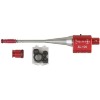show_me_2nd
Member
Santa brought me a Millett DMS-1 and Millett one piece cantilever scope mount for my LE6920. I want to install the gear myself. I'm thinking I should use use some locktite blue on the 8 screws that hold the half moon tops of the rings to the base but I'm wondering if there are any torque requirements or if locktite blue is the best thing to use.
The base locks into the picatinny with a single screw / bolt head type deal. Also thinking some locktite on that would help? Kicking myself in the head that I did not ask for a QD type mount.
Heading out to the LGS today to look for a laser bore sight and some kind of leveling device to help with alignment. Hoping I won't need to think about lapping, thinking that's more for long range precision work and I'm not there yet.
Thanks in advance for helpful advice / suggestions.
The base locks into the picatinny with a single screw / bolt head type deal. Also thinking some locktite on that would help? Kicking myself in the head that I did not ask for a QD type mount.
Heading out to the LGS today to look for a laser bore sight and some kind of leveling device to help with alignment. Hoping I won't need to think about lapping, thinking that's more for long range precision work and I'm not there yet.
Thanks in advance for helpful advice / suggestions.


